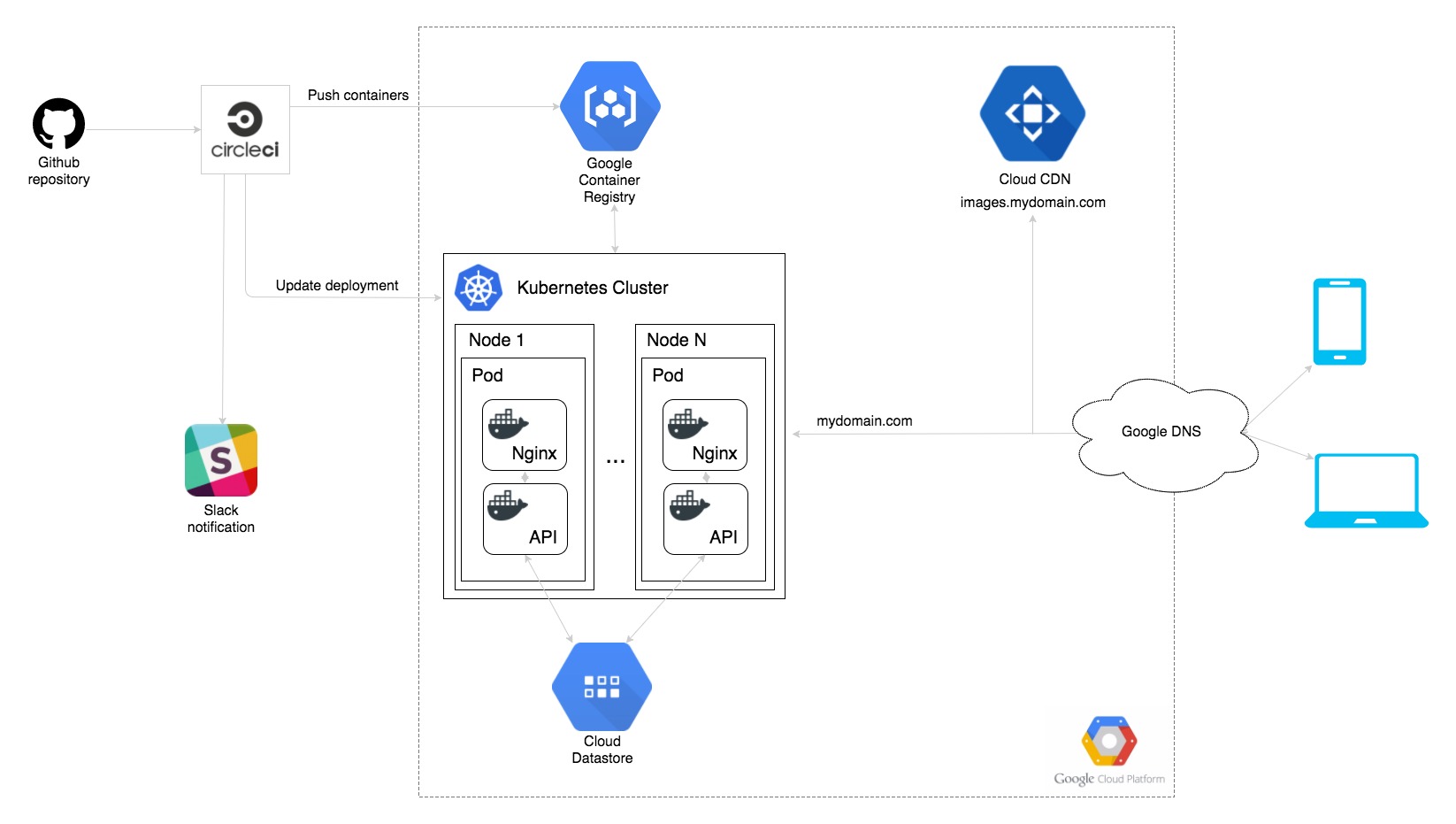Building a social media site - Infrastructure
In the past few days I’ve been working on setting up the infrastructure for my cloud webapp. I chose Google Cloud, because I had no previous experience with it. Sounds weird eh? You should always choose the right tools for the right job, but in this case it’s also a learning experience for me.
I’ve been mostly involved in projects using AWS, so I have a fairly good understanding of its capabilities. Hence I thought this is a good opportunity to put something live on another cloud platform to get a good comparison, see the pro/cons, etc.
I have to say that working with GCloud isn’t that much different. The services it offers are mostly comparable to AWS’. At least the ones I want to use anyway.
In this article we’re going to go through the architectural details of our new webapp.
(High-level infrastructure diagram)
Goals
When I started planning, I had a few basic requirements in mind regarding the operation and maintainability of the system.
- Proper source control
- End-to-end CI/CD pipeline
- Scalability
- Stateless execution, and immutable backend
- Cost efficiency
To be fair, I should have started with a very simple walking skeleton, but I’ve already had an Angular application and an API ready for deployment, so it was a bit more complicated to put everything in place.
Source Control
This was a no-brainer, as I love Git. I already have a Github subscription, so I created a new private repo, and that’s pretty much it.
CI/CD
I needed a continuous integration/deployment system which can build containers, runs on linux, has a bunch of 3rdParty integration, and free. I have to be honest, I started out with VSOnline but backed-out halfway through as I found it too MS tech focused (geez wonder why :)).
So I fell back to my usual choice: CircleCI. I’ve been using Circle since the early days, and find it just right for my projects. They recently released Circle 2.0 with a whole lot of new features. Their free-tier is amazing, you should be able to do pretty much everything you need for a small-medium sized project.
It nicely integrates with Github, Slack, GCloud / AWS. With a few click you can get everything up and running…as long as it’s a simple hello world.
Scalability
As I mentioned before, I decided to go with Kubernetes. Kubernetes is a container orchestrator allowing us to efficiently run, manage and scale containers on virtual or physical machines. It also provides self-healing, and zero-downtime deployments (and much-much more). I had bad experiences with spinning it up in AWS, but on GCloud it’s a breeze. This, accompanied by Google CDN for static files/images hosting will suit my needs well on the long run.
I chose Cloud Datastore as my DB engine, so I don’t have to deal with DB bottleneck, replication, and whatnot. It will nicely scale with my traffic, and that is good enough for now.
Stateless execution / immutability
I decided not to use sessions in my backend implementation as they’re are generally considered to be a bad concept. I strongly suggest you to check out this article for details. From the infrastracture viewpoint, it eliminates some complications from the backend. Thanks to this, it becomes very easy to horizontally scale the infrastructure without the hassle of managing a Redis/MemCached/etc cluster.
I’m encoding all necessary information in a JWT token, which is then used for authentication and basic data storage for the frontend (like user details).
Cost efficiency
With the current setup, I only have to pay for the followings:
- Github account
- Domain name
- 1 VM for my node (I’ll scale this up to 3 nodes before launching my site)
- Container registry (peanuts)
Google is nice enough to give you $300 after signing up for a cloud account, which can be used during the first 12months.
One click end-to-end deployment process
If you want to make your life easier, you better automate everything. You’ll never have to worry about releasing anything ever again.
Let’s see how a typical release cycle looks like:
- You push your code to your master branch.
- Via webhook integration, Circle picks up the changes and kicks off the build:
- Compile the 2 projects (frontend, and backend)
- Build 2 docker images from the build artifacts
- Push the new images to the private container registry, tagged with the build number
- Use kubectl to update the image versions in the cluster
- Send me a message on Slack with the build details
- The image version update triggers a Kubernetes deployment update, which does a zero-downtime upgrade
The whole process takes less than 5 minutes. Even this can be halved by subscribing to Circle’s layer caching service, which prevents the build server from re-downloading the build container images (we’re talking about 2-3Gb here - ouch!).
Improvement areas
The current setup is far from complete; or production ready. It’s definitely a nice start, but it still misses a few key requirements for normal operation.
I’m planning to add the following features during the next few months:
- Log aggregation (Stackdriver / ELK stack)
- Metrics and monitoring/alerting
- Blue/Green deployment
- Infrastructure-as-code (half done)
Coming up next…
I didn’t want to squeeze everything into this blog post, so I’m going to follow this up with another one going through the implementation details.
